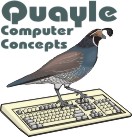


About Us
The Story of SWAMP
Early in 1998 Quayle Computer Concepts entered the national market of Self-Storage Management software with a windows-based program called "Storage/Warehouse Asset Management Program," or SWAMP for short. The path to getting there, however, was not short. Calvin and Gordon Quayle started building CQrt Self-Storage in 1977, Calvin managed the storage buildings, while Gordon finished school and become a professional computer programmer. Being naturally frugal, Calvin used manual billing and record keeping at first, then graduated to computers with a Burroughs B-20. He looked at professional software and found it much too expensive -- and also not written for the Burroughs BTOS operating system. However, using a word processor and a spreadsheet, he was soon creating computer printed invoices, late notices, lock out letters and envelopes. He also created occupancy and income records. Over the years, Gordon would write macros on the spreadsheets to speed things up and make them more accurate and easier to use. By this time Calvin had graduated to a Compaq Computer and to a windows operating system.
Gordon, meanwhile, had created Quayle Computer Concepts and a management program for an insurance company. He saw how many of the problems he solved with that project could be applied to the record keeping needs of self storage -- and SWAMP was born. Over the next two years Calvin used the program, made suggestions, Gordon added features, made his own suggestions and the program grew.
They felt that the program was ready for others to get involved, so it was offered to the self-service storage owners in the Eau Claire, Wisconsin area. Four managers bought the program. Each of them had suggestions for the program and further changes were made.
Version 1 of SWAMP went through five updates before they got to Version 2.0, which was offered to the national public for the first time at the Inside Self Storage Expo in Las Vegas in February of 1998. To accompany 2.0 an "Owners Manual" was prepared to guide the new owner through the initial process of getting started and the learning curve of getting used to operating the program.
The response to the program has been very positive. One woman said, "I love this program, now it's fun coming into work." Another manager said, "If it were not for your program I would be tearing my hair out by now." Several others have asked why it is so inexpensive, and the only answer we can come up with is that software programs should be inexpensive.
In response to a recent survey, Gordon answered the question, "What do you think is the next logical step for self-storage management software? "One of the most exciting things about working in the computer industry is riding the wave of emerging technology; from PCs to LANs to the Internet; from hard offices to telecommuting to virtual offices, from paper tape to magnetic media to optical disks. Technology will keep marching forward and so will the software that uses it. However, programmers often fall in love with the next new thing and spend time and money putting it in their software without giving thought to whether their customers really need it; and then software companies spend time and money convincing their customers that they do need it. . . .
"When I look at the next logical step for self-storage management software, I see the same thing I saw when I started programming twenty years ago: software that fulfills its promise of making your life easier; software that helps you manage your business; software that adapts to your way of doing things and doesn't force you to adapt to it; software that is affordable; software that saves you money and time; software that justifies your investment in your office equipment. Our motto at Quayle Computer Concepts is "making computers work for you." We are a father and son outfit, one has managed storage units for over twenty years and the other has been programming for nearly as long. It was a natural merger to combine this experience and create a software product specifically designed for the smaller operation at a reasonable price. We keep our overhead low and we listen to our customers. We will continue to add the features that our customers want. We are committed to making a software product that truly makes good on its promises. What more could you ask?"